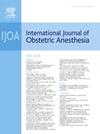Spinal anesthesia for cesarean delivery resulting in postdural puncture headache and intracranial subdural hematoma − a case report
IF 2.3
3区 医学
Q2 ANESTHESIOLOGY
引用次数: 0
Abstract
Background
Spinal anesthesia is routinely used for cesarean delivery. Intracranial subdural hematoma (SDH) is a potentially fatal complication of neuraxial anesthesia and is extremely uncommon. This report describes a case of SDH following uncomplicated spinal anesthesia for elective cesarean delivery and highlights the importance of timely intervention and patient follow-up.
Case
A 35-year-old patient with a history of hepatitis B underwent elective cesarean delivery under spinal anesthesia provided with a pencil-point 25G needle at the presumed L3-L4 interspace. She experienced a mild non-positional headache the next day managed with oral pain medications. After discharge, she presented twice for worsening headache symptoms. By the 12th postpartum day, symptoms were suggestive of post-dural puncture headache, prompting imaging that revealed a left-sided subdural hematoma with mass effect. After multidisciplinary consultation with neurosurgery, an epidural blood patch (18 mL) was performed. Despite worsening radiological findings, the patient experienced symptomatic relief. The patient was discharged with follow-up arranged at the institution’s headache clinic.
Conclusion
While post-dural puncture headache after unintended dural puncture may be common, serious complications such as SDH are rare and require prompt diagnosis and intervention. This case illustrates a rare but serious complication of an uncomplicated spinal anesthesia, highlighting the need for thorough follow-up and prompt interventions. This report underscores the importance of revising discharge instructions after neuraxial anesthesia to include education on symptoms of post-dural puncture headache and the necessity of timely re-evaluation if symptoms worsen.
剖宫产腰麻致硬膜后穿刺头痛及颅内硬膜下血肿1例报告
背景:脊髓麻醉通常用于剖宫产。颅内硬膜下血肿(SDH)是一个潜在的致命并发症的神经轴麻醉,是极其罕见的。本报告描述了一例无并发症的脊髓麻醉后选择性剖宫产SDH,并强调了及时干预和患者随访的重要性。病例1例,35岁,乙型肝炎病史,腰麻下择期剖宫产,25G铅笔尖针刺L3-L4间隙。第二天,她出现了轻微的非体位性头痛,口服止痛药治疗。出院后,因头痛症状加重两次就诊。到产后第12天,症状提示硬脑膜穿刺后头痛,提示影像学显示左侧硬脑膜下血肿伴肿块效应。经多学科神经外科会诊后,行硬膜外血贴(18ml)。尽管放射学表现恶化,但患者症状缓解。患者出院后安排在该机构的头痛门诊随访。结论意外硬膜穿刺后头痛常见,但SDH等严重并发症较少见,需及时诊断和干预。这个病例说明了一个罕见但严重的并发症的简单脊髓麻醉,强调需要彻底的随访和及时的干预。本报告强调了修改神经轴麻醉后出院说明书的重要性,包括对硬脊膜穿刺后头痛症状的教育,以及如果症状恶化及时重新评估的必要性。
本文章由计算机程序翻译,如有差异,请以英文原文为准。
求助全文
约1分钟内获得全文
求助全文
来源期刊
CiteScore
4.70
自引率
7.10%
发文量
285
审稿时长
58 days
期刊介绍:
The International Journal of Obstetric Anesthesia is the only journal publishing original articles devoted exclusively to obstetric anesthesia and bringing together all three of its principal components; anesthesia care for operative delivery and the perioperative period, pain relief in labour and care of the critically ill obstetric patient.
• Original research (both clinical and laboratory), short reports and case reports will be considered.
• The journal also publishes invited review articles and debates on topical and controversial subjects in the area of obstetric anesthesia.
• Articles on related topics such as perinatal physiology and pharmacology and all subjects of importance to obstetric anaesthetists/anesthesiologists are also welcome.
The journal is peer-reviewed by international experts. Scholarship is stressed to include the focus on discovery, application of knowledge across fields, and informing the medical community. Through the peer-review process, we hope to attest to the quality of scholarships and guide the Journal to extend and transform knowledge in this important and expanding area.

 求助内容:
求助内容: 应助结果提醒方式:
应助结果提醒方式:


